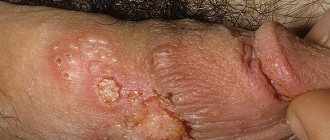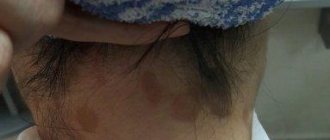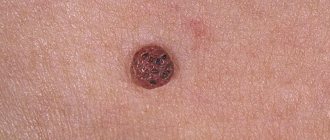The health of the intimate area is an important component of the normal life of a man and a woman. Any ailments or abnormalities make patients worry. A lump on the pubis is a common reason for visiting a doctor. When a tumor appears, you should not panic and make a dangerous diagnosis yourself.
Usually the lump turns out to be a benign neoplasm. Having diagnosed the disease, doctors prescribe treatment; it can be either conservative or surgical.
Causes of bumps
In medical practice, there are various factors that influence the formation of compactions. Symptoms in women and men are the same, depending on the disease. The ball may appear to the right or left of the pubis or in the middle of the intimate area.
Among the main seals and the reasons for their appearance are the following:
- Boils are an infectious and inflammatory process affecting the hair follicle. Through microtrauma on the skin, bacteria (staphylococci or streptococci) enter it. Bacteria cause the development of pus and inflammatory processes. A large red bump forms on the skin. The lump hurts a lot and pulsates. On palpation, a mobile and elastic ball is felt. Sometimes the patient’s general health worsens and body temperature rises. These are standard symptoms of furunculosis. Hypothermia, stressful situations, decreased immunity, and inflammatory processes in the body can cause the development of a boil.
- Hernia in the groin area - most often a hernia occurs in men. The main reasons are heavy lifting, frequent constipation, increased internal pressure in the abdominal area. When a hernia occurs, the abdominal organs prolapse into the scrotum or groin area. The ball is painless and is localized on the left or right side of the pubis. It doesn't cause any particular inconvenience. It is dangerous because it can pinch a loop of intestine. In this case, the patient feels severe pain, the intestines are pinched, the patient cannot empty the intestines, and intoxication of the body begins. The patient requires immediate surgery.
- Atheromas - they are also called cystic formations. These are benign tumors that often appear on the pubic area. Atheromas occur due to blockage of the sebaceous glands. The exudate has nowhere to go, as a result, it begins to accumulate inside the capsule in the sebaceous duct, expanding it. The cyst is a soft and mobile lump, with smooth and clear edges. The lump hurts due to inflammation and is chronic. Atheroma can periodically become inflamed (for example, during hypothermia or a stressful situation). You can get rid of it completely only surgically by removing the atheroma capsule.
- Lymphadenitis is an inflammation of the lymph node in the groin area. Lymph nodes become inflamed when immunity is reduced, during infectious and other diseases (sometimes with diseases of the pelvic organs or sexually transmitted infections). With lymphadenitis, bumps appear, fever and deterioration of health are possible. The seal on the pubis interferes with walking, causing discomfort.
- Lipoma is a benign tumor, like a lump in an intimate place, it is formed from adipose tissue. This is an absolutely painless neoplasm. On palpation, a soft and movable compaction is felt. Lipoma does not go away on its own, is not subject to regression, and can only be removed surgically.
You can look at photos of different types of pubic seals online and on thematic forums. But you should focus on them only after an official diagnosis has been made.
Associated symptoms
The formation of lumps in the groin in women can be painless and unnoticed, but in most cases it is accompanied by certain symptoms, allowing a specialist to assume the possible nature of the pathology and the degree of its potential danger to health. The most common manifestations:
- Painful sensations. They accompany most processes occurring in the body. They are considered characteristic of lymphadenitis, inguinal hernia, and oncology. Pain occurs when there is contact or pressure in the area of the lump.
- Bulging. Indicates inflammation with the formation of a purulent process or the formation of an inguinal hernia. As it increases, it begins to bulge, causing discomfort when moving or wearing underwear. In the future, it becomes the cause of serious complications and can lead to tissue necrosis or blood poisoning.
- Spontaneous opening. This phenomenon is typical for seals that look like a capsule with a purulent mass. It occurs in a number of diseases - inflammation of the sebaceous glands, hidradenitis, furunculosis, bartholinitis. The sac ruptures after 10-14 days and is accompanied by an outpouring of purulent contents. After the capsule is cleansed, scarring of the wound begins. Recurrence of the disease is possible.
- Asymptomatic. Characteristic for the development of formations of a benign nature. An increase in compaction is indicated only by emerging discomfort. The tumor interferes with movement, while wearing or changing underwear and is a cosmetic defect.
It is important to know! Therefore, in the early stages, the appearance of a lump is not accompanied by any unpleasant sensations. Specific symptoms arise as the pathology progresses.
Other entities
In addition to the above, there are other pubic bumps in women and men. They are a little less common.
Other reasons why seals appear:
- Syphilitic formations are chancre. This is a painless neoplasm. Caused by the bacterium Treponema pallidum. The diameter of the chancre is one or two centimeters. Syphilis is transmitted sexually, but transmission through household methods is not excluded. But in this case, the hard chancre will not be on the pubis, but, for example, in the mouth or on another part of the body.
- Dermatofibroma is a benign neoplasm. The exact cause of its occurrence is still not known. The tumor is growing slowly. This is a small red or brown bump that gradually gets larger. The pubic ball can only be removed surgically.
- Folliculitis or pseudofolliculitis are diseases in which the hairs in the groin grow abnormally. They grow into the skin or begin to grow deep into the dermis. This causes the appearance of balls in the intimate area. The seal is painful. As a result, ulcers form, inside which a hair grows.
- Lymphoma is a dangerous malignant neoplasm. The tumor grows from lymphatic tissue. With lymphoma, a lump forms on the side of the pubis, its edges are uneven. Additional symptoms of the disease are also present. These include sudden weight loss, deterioration in health, constant loss of strength, and increased temperature. It can only be treated surgically.
If tumors are detected on the pubis, you should not self-medicate. As a result, you may miss time to treat the disease. This will lead to complications and the recovery process will be delayed.
Types of papillomas
All warts in the pubic area can be combined into two main types:
- Pointed, the size of which does not exceed a couple of millimeters. They look like small nipples. The danger of genital warts is that they can lead to cervical cancer in women, and the risks for men include damage to the urethra. Detection of condylomas in the pubic part of men is more often likely to be on the genital organ, often on the foreskin. In women, they are found on the labia, pubis and vagina.
- Thread-like. The size of growths of this type is no more than 5 mm. There are single papillomas or warts, but with the same degree of probability there are multiple ones. Again, a decrease in immunity can lead to their additional growth.
Clinical picture
Symptoms in people of different genders and ages occur in a similar way. At first, the ball may be small and not show itself in any way. But gradually the symptoms increase. Finally, patients notice that a lump has appeared on their pubic area.
Swelling of the pubis is observed, patients are tormented by painful sensations (with boils the pain is pulsating), itching and burning are likely. An important sign is hyperemia or redness of the inflamed area.
Pus usually accumulates inside the lump. As the cone matures, it bursts and the exudate comes out. But sometimes a severe abscess is diagnosed, then the ball must be urgently opened surgically.
Purulent bumps on the pubis - photos and symptoms
bump
A lump under the skin on the pubis rarely occurs without symptoms. Usually this phenomenon is accompanied by certain clinical manifestations. The most pronounced of them is pain syndrome. Painful sensations vary depending on the reason for which disease the purulent lump appeared. The most painful lumps are those caused by folliculitis and lymphoma.
Another characteristic sign is hyperemia. It is characterized by redness of the skin in the affected area. Sometimes body temperature rises.
Lump with pus on the pubis in women
A pronounced clinical manifestation of this phenomenon is the release of the contents of the compaction. If we are talking about cysts, then it is transparent, with abscesses it is bloody with purulent impurities. If it is a syphilitic chancre, then the contents of the seal are bloody and have a pungent odor.
However, relying only on clinical manifestations, it is not possible to determine the nature of the neoplasm. You will need to undergo some examinations.
Treatment
Therapeutic measures depend on the disease. In most cases, the lump can only be dealt with surgically - the seal is excised using a laser, scalpel or other methods. But in some cases, conservative therapy is also possible.
In the initial stages of lymphadenitis, the patient is recommended to take antibiotics. If a small boil is diagnosed, then you can cope with it with the help of pharmaceutical ointments (Ichthyol or Vishnevsky ointment). Surgeons also recommend taking a course of antibiotics (5 to 10 days). Syphilis is also treated with courses of antimicrobial drugs.
After treatment, you can take vitamins and immunomodulators to improve the immune system. But you shouldn’t choose medications on your own; it’s better to ask your doctor about it.
For atheroma, lipoma, hernia and other tumors, surgical intervention is prescribed.
Treatment of growths on the pubis
Therapy for warts in intimate places, like most other diseases, includes:
- medication treatment;
- surgical removal of condylomas;
- traditional medicine methods.
Drug therapy
Pharmaceutical drugs are prescribed only by a doctor. If there is only one wart and is small in size, then antiviral ointments are used as therapy, which are applied to the growth itself and the area of skin around it.
One of the most important points when treating warts is strengthening the immune system!
When there is no result or there is more than one wart, treatment is aimed at strengthening the immune system of the sick person. Immunostimulating drugs are prescribed along with vitamins and proper nutrition, because the approach must be comprehensive. Weak immunity is not able to resist infection, including the papilloma virus.
Removal in the clinic
The most effective method of getting rid of growths is mechanical removal. When contacting the clinic, the patient will be given several options for removing genital or filiform condylomas:
- excision with a scalpel is a traumatic option, but available to every patient; it is more often used when a large area of skin is affected;
- laser method, when warts are removed layer by layer using a heat beam;
- electrocoagulation, when the growth is exposed to electric current;
- freezing papillomas using liquid nitrogen;
- cutting off the growth with a radio knife is a method that has the least trauma.
There is no single best way to remove papillomas among those presented. Each of them has an efficiency of about 90%.
After removal, you will need to undergo antiviral and immunostimulating therapy to prevent relapse.
We treat warts in intimate places with folk remedies
Treatment of warts in some cases is acceptable at home. The plants around us contain components that can burn out growths and remove papillomas. Before starting home treatment, it is better to consult a doctor.
Let's consider the most effective methods of traditional medicine:
- Celandine juice. The plant is easy to find in any yard in the summer. Fresh juice should be applied to the growth several times a day. In winter, it is recommended to use plant extract from the pharmacy.
- Fir oil has the same effect. Twice a day you need to lubricate problem areas with it until the condyloma disappears.
- Raw potato juice, when applied daily to a wart, will get rid of the growth within a month.
- Garlic compresses also solve the problem. The clove is crushed and mixed with cream in equal proportions, applied to the problem area and left for several hours.
Diagnostics
Even if a woman does not feel any discomfort and, apart from the formation of a lump on the pubis, nothing else worries her, there are no suspicious symptoms, she should still visit a medical facility.
- If the lump is painless and does not interfere with anything, then you should first go to a surgeon to rule out such a phenomenon as a benign formation.
- But if you experience any symptoms and a feeling of general malaise, it is recommended that you first go for a consultation with a dermatovenereologist and an infectious disease doctor.
Any diagnostic procedures are prescribed on an individual basis for each specific patient. In addition to the mandatory general urine and blood tests, a flora smear from the urethra or vagina is prescribed. More complex diagnostic methods may be required: ELISA and PCR. If the development of a malignant tumor is suspected, a biopsy is performed.
We recommend:
A boil in the groin of women - reasons;Pimples in an intimate place - how to treat;
Causes of pubic itching in women -.











